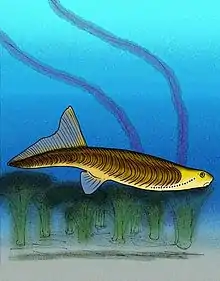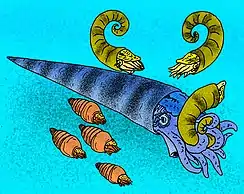Aeronian
In the geologic timescale, the Aeronian is an age of the Llandovery epoch of the Silurian period of the Paleozoic era of the Phanerozoic eon that began 440.8 ± 1.2 Ma and ended 438.5 ± 1.1 Ma (million years ago). The Aeronian age succeeds the Rhuddanian age and precedes the Telychian age, all in the same epoch.[4]
| Aeronian | |
|---|---|
| 440.8 ± 1.2 – 438.5 ± 1.1 Ma | |
| Chronology | |
Epochs in the Silurian -444 — – -442 — – -440 — – -438 — – -436 — – -434 — – -432 — – -430 — – -428 — – -426 — – -424 — – -422 — – -420 — – -418 — Epochs of the Silurian Period. Axis scale: millions of years ago. | |
| Etymology | |
| Name formality | Formal |
| Usage information | |
| Celestial body | Earth |
| Regional usage | Global (ICS) |
| Time scale(s) used | ICS Time Scale |
| Definition | |
| Chronological unit | Age |
| Stratigraphic unit | Stage |
| Time span formality | Formal |
| Lower boundary definition | FAD of the Graptolite Monograptus austerus sequens |
| Lower boundary GSSP | Trefawr Track Section, Llandovery, Wales, UK 52.0300°N 3.7000°W |
| GSSP ratified | 1984[3] |
| Upper boundary definition | Just above LAD of the Brachiopod Eocoelia intermedia, below FAD of lowest succeeding species Eocoelia curtisi |
| Upper boundary GSSP | Cefn-cerig Road Section, Llandovery, Wales, UK 51.9700°N 3.7900°W |
| GSSP ratified | 1984[3] |
GSSP
The GSSP is located in the Trefawr Track section, 500m north of Cwm-coed-Aeron Farm, Wales, UK.[5] The GSSP lies within the gently-dipping blocky mudstones of the Trefawr Formation, which principally yield abundant and diverse shelly faunas, but also contain enough graptolites to allow recognition of several biozones.[6]
Palaeontology
Agnathans
| Agnathans of the Aeronian | ||||
|---|---|---|---|---|
| Taxa | Presence | Location | Description | Images |
| Rhuddanian-Telychian | It had an elongated body and a dorsal fin and an anal fin near the back third of its body. |  Jamoytius kerwoodi | ||
Cephalopods
| Cephalopods of the Aeronian | ||||
|---|---|---|---|---|
| Taxa | Presence | Location | Description | Images |
| Dapingian-Homerian | The shallow seas of Laurentia, Baltica and Siberia.[7] | Head was soft muscular tissue at the opening of hard cone-like shell. |  Cameroceras, shown feeding on an Aphetoceras, while a quartet of Cyclostomiceras swim by. | |
References
- Jeppsson, L.; Calner, M. (2007). "The Silurian Mulde Event and a scenario for secundo—secundo events". Earth and Environmental Science Transactions of the Royal Society of Edinburgh. 93 (02): 135–154. doi:10.1017/S0263593300000377.
- Munnecke, A.; Samtleben, C.; Bickert, T. (2003). "The Ireviken Event in the lower Silurian of Gotland, Sweden-relation to similar Palaeozoic and Proterozoic events". Palaeogeography, Palaeoclimatology, Palaeoecology. 195 (1): 99–124. doi:10.1016/S0031-0182(03)00304-3.
- Holland, C. (June 1985). "Series and Stages of the Silurian System". 8 (2): 101–103. doi:10.18814/epiiugs/1985/v8i2/005. Retrieved 15 December 2020. Cite journal requires
|journal=(help) - "GSSP Table - All Periods". International Commission on Stratigraphy. Retrieved 2018-09-15.
- Gradstein, Felix M.; Ogg, James G.; Smith, Alan G. (2004). A Geologic Time Scale 2004. ISBN 9780521786737.
- "GSSP for Aeronian Stage". International Commission on Stratigraphy. Retrieved September 15, 2018.
- Frey, R.C. 1995. "Middle and Upper Ordovician nautiloid cephalopods of the Cincinnati Arch region of Kentucky, Indiana, and Ohio" (PDF). U.S. Geological Survey, p.73
This article is issued from Wikipedia. The text is licensed under Creative Commons - Attribution - Sharealike. Additional terms may apply for the media files.
